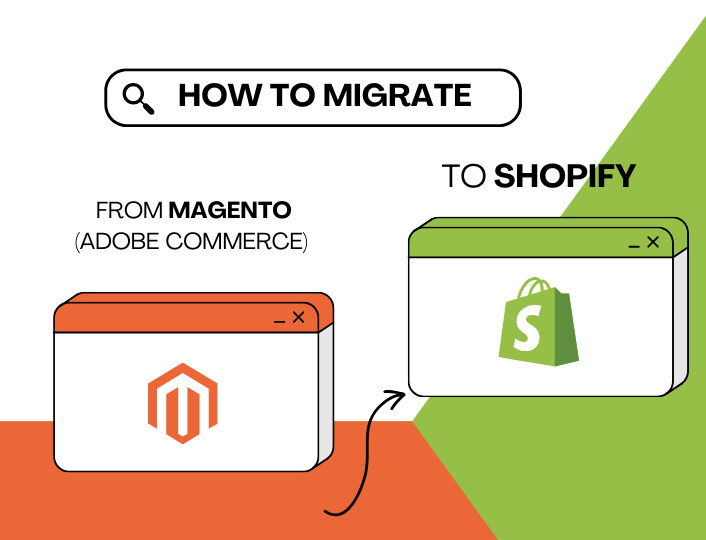When you see a site named BackRub, what would be your best guess that they would be selling? Wellness brand? Electronics? Well, BackRub is now Google. Yup, the tech giant we all know!
It’s not unusual anymore to see websites where the store name sounds great, and yet they are not great for branding. Hence, a rebranding comes into play.
Having strong branding means having a good domain name and store name that aligns with your business’s product, vision, and goals. In fact, most companies allocate 10-15% marketing budget towards rebranding and branding, because it is critical to their growth.
Trust us, it is not as hard as you think to change Shopify store name and domain name. After all, a fresh start can do wonders. If you are considering a rebrand for your Shopify store but wondering how does Shopify work, don’t worry we have you covered! Explore the step-by-step guide on how to change your Shopify store name and domain name in no time!
Shopify Store Name vs. Shopify Store Domain: What is the Difference?


Before we jump into the steps, let’s try to understand the difference between the Shopify store name and the Shopify store domain. This section is especially important if you are new to the world of eCommerce.
What is Shopify Store Name?
Your Shopify store name is the very essence of your brand identity. It is what acts as the front-facing representative of your business, and your business will be known by this name. Hence, it should ideally convey your business’s personality, values, offerings, and much more.
But a compelling store name is much more than an identifier. It has the power to create a certain impression of your business on your prospects and customers, and you don’t want to mess with that.
For instance, think of Shopify stores like Gymshark or Fashionnova. Do you find any common traits in their store names?


Both these brand names:
- Are concise.
- Is memorable.
- Conveys the brand’s key business segment in its name (Fashionnova being a fashion brand and Gymshark selling workout and gym clothing).
In short, when you decide on your online store name, you must go for one that is:
- Short and sweet (easy to remember).
- Reflects your brand’s ideologies.
- Avoids cliche terms and phrases
- Satisfies the SEO checklist (if your target audience is gym enthusiasts and fitness experts, then having terms like “gym” and “fitness” in your store name can do wonders).
- And most importantly, check if the domain for your store name is available. You don’t want your store name and domain to be different.
If your existing brand name doesn’t have the magnetic pull it needs to grab the attention of your target audience in a crowded online marketplace, then it’s time to change it. A store name that doesn’t connect with the audience or differentiate itself from the competition is a missed opportunity. So, follow the above pointers to choose a name that strikes the right chord between uniqueness and relevance.
What is a Shopify Store Domain?
The Shopify domain name is essentially your digital address. It is the URL your prospective customers and users have to type in and search for on the web to find you and access your website, like www.yourstorename.com.
Now, this is more towards the technical side, and understanding the technical aspects of a domain name involves the following:
- Picking an appropriate Top-Level Domain (TLD) extension. This is the suffix that follows your domain name, such as .com, .org, .net, .co, etc. This is used to identify certain elements of your website, including its purpose, owner, or even geographical area.
- Avoiding complex inclusions in your web address like hyphens or numbers. This can be hard to remember; hence, avoiding them can ensure alignment with your brand identity.
A well-drafted domain name means better accessibility, easier for customers to recall, and, of course, better visibility on the web through SEO.
Choosing the Right Combination of Store and Domain Name


Source: Canva
Now that you know the difference between a Shopify store name and a domain, let’s try to find the perfect balance between them for your Shopify store. Here are a few takeaways to follow:
-
Emphasize Brand Consistency
When it comes to eCommerce, consistency is your king. Your store name and domain must align seamlessly so that when your customers remember your name, they can easily recall your domain, too. This is great for building authenticity and trust.
-
Choose a Reflective Domain
Make your domain an extension of your store name. Go for a domain name name that mirrors your store name. We also recommend considering popular TLD extensions like .com for a universal appeal and for a broader reach or .store for a retail-centric vibe.
-
Consider Future Expansion
Think long-term – choose a name and domain that allow for business growth and diversification. Prepare your future business expansion plan, lay out your goals and activities, and avoid the scope of rebranding and the challenges that come along with it down the road.
-
Incorporate Keywords Strategically
If possible, integrate relevant keywords into your store name and domain for SEO benefits. Keywords can enhance your store’s visibility in search engine results.
-
Test Pronunciation
Don’t forget to test out your domain and store’s name pronunciation. The easier it is to pronounce, the easier it will be to remember. With the rise of voice-activated devices, a name that’s voice-friendly can boost discoverability. And it helps a lot in word-of-mouth marketing, enhancing brand recall.
-
Seek Feedback Continuously
Don’t be afraid to go out there and gather feedback. Be it from your friends, family, or colleagues, get a word from them on your domain and store name combination. on your chosen combination. Outside perspectives can catch potential issues you might have overlooked.
4 Reasons for Changing Your Shopify Store Name
Undoubtedly, changing your Shopify store name can be of strategic advantage to your business. Here are some of the most common reasons brands and businesses consider renaming or rebranding their business.
-
Rebranding for Growth
When you are a part of the ever-competitive eCommerce world, you must make growth your most important goal. Rebranding can play an important role in this.
For instance, take giants like Nike and Spotify. They didn’t become global icons overnight; they underwent strategic rebrands that propelled them forward. Nike transformed from Blue Ribbon Sports to Nike, embracing a name that has become synonymous with athletic excellence. Similarly, Spotify evolved from a Swedish start-up named Spotify AB to a global music streaming giant. These success stories showcase the transformative impact of rebranding for sustained growth.


Source: LogoMyWay
If your business is on the brink of expansion, a well-thought-out rebrand can be the catalyst for reaching new heights, including a better Shopify conversion rate, new customers, etc.
-
Merging or Acquiring Another Store
Mergers and acquisitions are common in eCommerce and retail. When your business joins forces with another or acquires a new entity, a change in your store name might be on the horizon. This isn’t just about combining logos; it’s about creating a cohesive brand identity. This new identity covers everything from your store name to theme, vision, mission, etc., for paving the pathway for the two businesses to come together.
If your business too is considering the beginning of a new chapter like this, then changing your brand name can symbolize the shared vision for your combined businesses.
-
Legal Issues and Trademark Infringements
Legal matters might not be the most exciting aspect of business, but they are critical. If your current store name runs into trademark issues or faces legal challenges, a swift name change is a practical solution.
One thing to remember here is that legal disputes can be extremely time-consuming and costly. Hence, a rebranding can help you avoid such challenges. In this case, it could be the best solution to safeguarding your brand’s integrity.
-
Personal Preference and Evolving Vision


Source: Canva
Sometimes, a change in your Shopify store name might occur due to personal preference. As businesses grow, you can expect some of your business’s vision to grow and change, too. In order to encapsulate this vision, you might consider renaming your business. Trust your instincts – if your store name no longer reflects your vision or personal preferences, a change can be a positive step forward.
How to Change Your Shopify Store Name?
Now, let’s get to the most important part of this blog, which is how to change your Shopify store name. Here are the three steps you need to follow to have your online store name changed successfully.
Step 1: Planning and Preparation
Source: Canva
Start with your plan for Shopify store name change by envisioning the future of your brand. Look into your target audience, their expectations, and your business’s core values. Don’t forget that your new store name should connect you to the audience and bring both parties closer, and not otherwise.
So, brainstorm as many potential shop name ideas as possible. For every name you are considering, do a simultaneous domain check to avoid any last-minute hassles. Use online tools like GoDaddy or Hostinger to verify domain availability, ensuring that your desired name can be translated into a web address. Additionally, perform a thorough check for trademark conflicts to avoid legal complications down the road.
Once you have finally decided to undergo this name change, create a rebranding plan for informing your customers and stakeholders. The reasons for this must be relevant and sensible.
Step 2: Updating Your Shopify Store Settings


Source: Canva
Now that you have your new name ready let’s walk through the process of updating it in your Shopify store settings.
#1 – Access your Shopify dashboard settings


Source: Shopify
In your Shopify account, go to the dashboard, locate the Settings link (located in the bottom left corner) and click on it to navigate to the settings page.
#2 – Navigate to store details


Source: Shopify
Within the settings, you can find “Store details.” Click on it and look for the “Edit” option in the “Basic information” block.
#3 – Update your store information


Source: Shopify
This is where you can edit your store name, phone number, and contact information. Enter your new store name in the designated field.
#4 – Save the changes
After entering the new name, click on the “Save” button, either at the bottom of the page or in the upper right corner. Your store name is now updated.
Step 3: Redirecting Your Old Domain to the New One
Source: Canva
Now, you have updated the store name in Shopify settings. Time to dust your hands and watch those customers come flying in? Well, not yet. There’s one small step (a big step, actually) that cannot be missed. That is, setting up redirects. This is focused on ensuring that visitors using the old domain are automatically directed to the new one.
This is crucial for preserving even your SEO power and maintaining a seamless customer experience. Shopify lets you create URL redirects, product redirects, and many tools so you can easily set up 301 redirects. These are digital breadcrumbs that tell search engines and browsers your new address. Alternatively, if you’re comfortable with tech, you can configure redirects through your domain registrar’s DNS settings.
How to Change Your Shopify Domain?
You have your store name on the clear, and it’s now time to change your Shopify domain name. Here’s a step-by-step guide broken down into three clear and actionable steps.
Step 1: Considerations for Choosing a New Domain
Source: Canva
Before diving into the domain-changing process, let’s go over a few things we discussed before.
- Your new domain name should be consistent across your brand name, store name, and domain, reinforcing your identity.
- If possible, incorporate relevant keywords into your domain. This can enhance your store’s visibility in search engine results, making it easier for potential customers to find you.
- Check if your desired domain name is available as a handle on major social media platforms (platforms where your target audience is present).
- If your store caters to a specific locality, consider including location-based elements in your domain.
Step 2: Purchasing and Transferring Your New Domain


Source: Canva
Once you’ve settled on the perfect custom domain, the next step is to acquire it and transfer it to your Shopify store. It’s a straightforward process. Here’s what you need to do:
-
Buying from a Registrar
Choose a reputable domain registrar to purchase your new domain. This is because a good registrar ensures a smooth process and ongoing support. You can buy a domain through Shopify itself,


Source: Canva
-
Domain Transfer Options and Costs
Also, consider domain transfer options, like registration duration and potential costs. This can help you make informed decisions as it may include additional costs. You can also transfer your third-party domain to Shopify for centralized management. Once transferred, you can handle all settings in your Shopify admin, simplifying domain control.
Step 3: Connecting Your New Domain to Your Shopify Store
Completing the process involves connecting your new domain to your Shopify store. Whether you purchased your domain from a popular provider such as Google Domains or from any third-party registrar, here’s how you can smoothly integrate your new domain:
-
Automatic Connection for Specific Providers
If you purchased your domain from third-party domain registrars, you can utilize Shopify’s automatic connection feature. This makes the process quicker and more efficient.
For automatic connection, follow these steps:
- From your Shopify admin, go to Settings > Domains.
- Click “Connect existing domain.”
- Enter your domain, e.g., flower-darlings.info, and click “Next.”
- Choose “Connect automatically.”
- Log in to your domain registrar account.
- Click “Connect” and then “Close.”
The verification can take up to 48 hours, and on completion, you can find your domain listed under the third-party domains section of the Domains page with the status “Connected.”
-
Manual Connection if Needed
If you want to connect your domain manually to your Shopify store from within your third-party domain provider account, you can do that, too. This is recommended as a fallback option if the automatic connection faces difficulties.
Steps to Follow After Connecting Your Domain (Optional)
- Set Up Your Email
After connecting your domain, configure your email settings to ensure professional communication. You can set up a custom email address to add to your brand’s professionalism and trustworthiness.
- Make Your Domain the Primary Domain
Also, consider making your new domain the primary domain for your Shopify store. This strengthens your brand’s online identity and provides a consistent experience for customers.
Possible Impact of Changing Your Shopify Store Name and Domain
And there you have it. You have completed the “change Shopify store name and domain” mission. But wait! There’s more.
You must be wondering if changing your Shopify store name and domain has any impact on your business. So, let’s do a quick analysis of the possible implications and matters you can expect or take necessary precautions for.
#1 – SEO
This shouldn’t be of any surprise to you. When you change your Shopify store name and domain, it is going to have some impact on your Search Engine Optimization (SEO). SEO plays a key role in determining your online visibility, and any sudden changes can certainly influence your search engine rankings.
However, there are ways to mitigate the effects of SEO, including:
- Setting up your redirects accurately.
- Updating your meta tags, headers, and content to reflect the new brand identity.
#2 – Customer Communication and Brand Engagement
Next up is customer communication and engagement. You can expect some confusion with your customers at the time of rebranding. For this very reason, we recommend keeping them in the loop from the beginning.
You can keep your TA informed through emails, social media posts, and, of course, your website. Back up your updates with reasons for the rebranding to reassure them that the quality and value of your products/services are still the same or better, in alignment with their expectations. Making them feel a part of the journey makes them more likely to embrace the change positively.
Key Takeaway
When you are all done with the rebranding process, don’t forget to measure its success. Start by defining clear metrics and KPIs and monitor them continuously. You can utilize tools like Google Analytics to track user behavior and engagement.
Follow this quick guide through your entire rebranding journey, and breeze through the rebranding transition in a breeze. Good luck!



